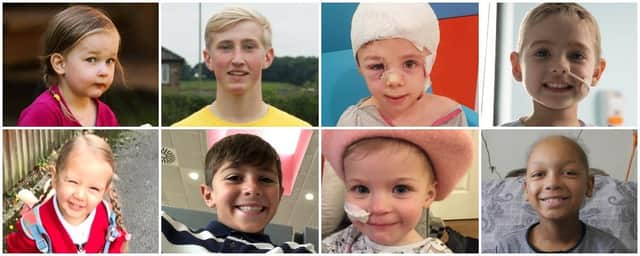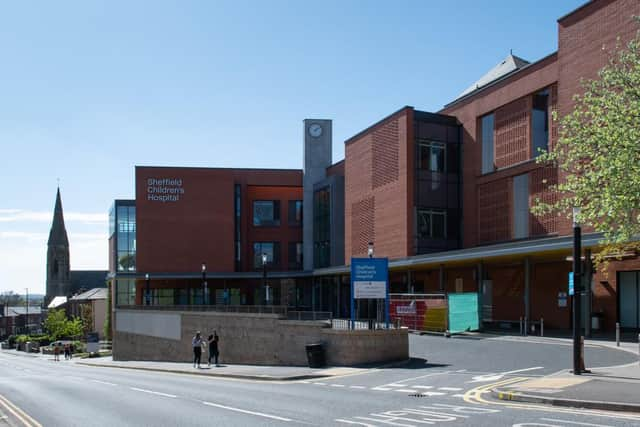Fundraising for Sheffield Children’s Hospital set to fall by £2.5m due to the coronavirus pandemic


The timeline for building the Cancer Ward, Emergency Department and on-site Helipad is now uncertain due to the coronavirus pandemic and hospital bosses are appealing to the public for help.
The Children’s Hospital Charity’s Director, David Vernon-Edwards said: “As a Charity, we are looking at a decline in fundraising of around £2.5m by the end of the financial year due to the COVID-19 crisis.
Advertisement
Hide AdAdvertisement
Hide Ad“Put simply, the less we raise together, the longer patients at Sheffield Children’s will have to wait for the upgraded environment they deserve.


“These projects are vital and there is still so much more we need to do to support the hospital and to ensure this pandemic doesn’t have a detrimental long-term impact on the support the charity provides to the staff and young patients.”
Two years ago The Children’s Hospital Charity launched its biggest-ever appeal to transform Sheffield Children’s for thousands of patients who visit every year.
The Building a Better Future appeal was launched in 2018 to build a brand new Safeguarding Support Unit, Cancer and Leukaemia ward, Emergency Department and on-site Helipad at Sheffield Children’s Hospital.
Advertisement
Hide AdAdvertisement
Hide AdSo far more than £5million has been raised towards the projects, which will be solely funded by charity donations. This has already enabled work to be completed on the state-of-the-art Safeguarding Support Unit which opened to patients in December 2019.
However, the coronavirus pandemic has caused a significant fall in fundraising, leaving the timeline for the remaining projects in doubt.
Mr Vernon-Edwards added: “We’re doing everything we can to raise as much as possible this year, but we felt it was important to share this information with the public, particularly given how vital our fundraising is to Sheffield Children’s.”
Transforming all three areas will benefit children far beyond the city limits. The Emergency Department at Sheffield Children’s Hospital was built to see 32,000 children every year but now sees more than 58,000 young patients every 12 months from across South Yorkshire, Derbyshire and Lincolnshire.
Advertisement
Hide AdAdvertisement
Hide AdThe Cancer and Leukaemia ward at Sheffield Children’s is one of just 20 principle treatment centres in the UK, seeing children as far south as Northampton, while patients arriving by air ambulance from across the region and requiring critical care currently land in a public park opposite the hospital.
The pandemic has seen major events including organised runs and walks supporting the appeal rescheduled, while The Children’s Hospital Charity’s city-wide public arts trail The Bears of Sheffield and overseas Inca Trail challenge have both been postponed until 2021.
More traditional ways of showing support including charity balls, bake sales and raffles are also no longer possible in times of social distancing. Meanwhile, scores of workplaces and schools supporting the efforts to redevelop Sheffield Children’s either remain closed, have reduced in size or are focusing on business continuity during times of economic uncertainty.
Following the onset of the coronavirus pandemic, the Charity launched an emergency appeal to help Sheffield Children’s through the unprecedented and ever-evolving changes it caused.
Advertisement
Hide AdAdvertisement
Hide AdMore than £90,000 was raised thanks to individual donations, text donations, Facebook fundraisers and events as well as a significant donation from professional golfer and The Children’s Hospital Charity’s patron, Matt Fitzpatrick.
The appeal funded play materials for patients, staff wellbeing resources and training to support the Nightingale programme. It also funded equipment to enable patients to monitor their conditions at home and reduce face-to-face contact. Equipment for staff on the Intensive Care Unit was also provided, helping to establish airways in patients with difficult respiratory conditions.
During this time, Sheffield Children’s took on all emergency children’s surgery to help support hospitals in South Yorkshire and Bassetlaw. Over 150 patients were helped through this pathway alone, which is now being stepped back as neighbouring hospitals begin to have the capacity to care for patients as normal.
However, while the pressure from the coronavirus seemingly eases on the frontline, its impact on long-term fundraising to ensure young patients have the best possible experience at Sheffield Children’s may have only just begun.
Advertisement
Hide AdAdvertisement
Hide AdDavid Vernon-Edwards added: “We understand these are difficult times for everyone, but if you are able to support us in any way, whether it is by planning a fundraiser, giving what you can or even just telling a friend just how special Sheffield Children’s Hospital is, we would be very grateful.
“The new Emergency Department, Cancer and Leukaemia ward and Helipad will change lives for generations and we’re determined no child has to wait a moment longer for that improvement than is absolutely necessary.”
To make a donation to support the patients and staff at Sheffield Children’s, visit www.tchc.org.uk, call 0114 321 2470 or text SHEFFCHILDRENS to 70085 to donate £5.
This costs £5 plus your standard message rate.
The Children’s Hospital Charity funds projects that are over and above the standard NHS provision.
Money raised through donations funds four key areas; medical equipment, research, new facilities and improvements to the environment.